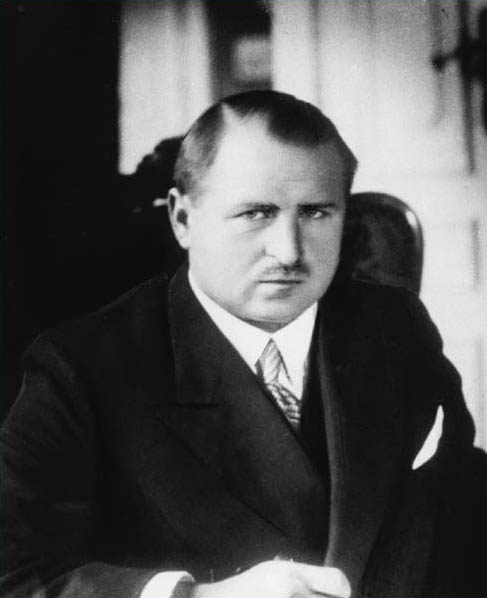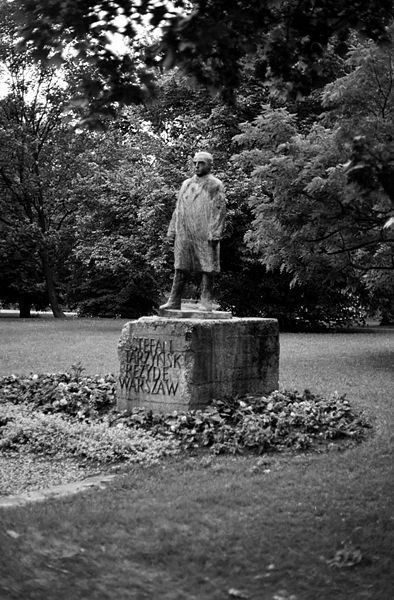<Back to Index>
- Economist and President of Warsaw Stefan Starzyński, 1893
- Writer Samuel Richardson, 1689
- General of the Imperial Russian Army Aleskei Alekseevich Brusilov, 1853
PAGE SPONSOR


Stefan Starzyński (August 19, 1893 - c. October 17, 1943) was a Polish politician, economist, writer and statesman, President of Warsaw before and during the Siege of Warsaw in 1939.
Starzyński was born on August 19, 1893 in Warsaw. After graduating from gymnasium, he enrolled in the Department of Economics at the Higher School of Trade (Wyższe Kursy Handlowe), a private run university. In 1909 he also joined various patriotic organizations, including the Riflemen's Association (Związek Strzelecki).
In August 1914, after the outbreak of the Great War, he joined Piłsudski's Polish Legions and
became an ordinary soldier in the 1st Brigade. He took part in all
battles and skirmishes of his Brigade and was quickly promoted to
officer. After the Pledge Crisis in 1917 he was arrested and, together with most of his colleagues, interned in Beniaminów. In November 1918 he joined the Polish Army and became the Chief of Staff of the 9th Polish Infantry Division. During the Polish - Bolshevik War he was transferred to the 2nd Department of the General Staff, which carried out mostly intelligence tasks. After demobilization he remained in public service. He supervised one of the repatriation commissions in Moscow and later one of the departments of the Ministry of Treasury. In the years 1929 - 30 and 1931 - 32 he was a deputy minister of the treasury. In 1930 he became a member of Polish Sejm for a three years period as a member of Bezpartyjny Blok Współpracy z Rządem (BBWR). He was also a deputy president of Bank Gospodarstwa Krajowego, one of the biggest Polish banks. During his life he published several academic papers on the economy. In
the early 1930s Warsaw had a huge hole in its budget. The city's
development had been halted by a lack of funds while the population
continued to grow rapidly. On August 1, 1934, Starzyński was chosen by
the Sanacja régime
to become the president of Warsaw, and was given special powers. Local
authorities were disbanded and Starzyński became responsible only to the central government. At first Starzyński was viewed by the majority of Varsovians as yet another Sanacja stooge
imposed on a city that mostly supported the opposition. But he soon
gained popularity, even among his former enemies. He initiated a plan
for fast - track reform of the financial system. The money saved thanks to
these reforms was reinvested in public works that reduced unemployment. He managed to electrify the suburbs of Wola and Grochów, pave all the major roads out of Warsaw, and to connect the city centre with the newly built northern district of Żoliborz through a bridge over the northern railway line. These actions earned him the nickname "president of the suburbs". He became popular among the inhabitants of borough of Śródmieście (city
centre) for his action of planting trees and flowers along the main
streets. Starzyński also ordered the creation of a huge park in Wola and
several minor green areas in other parts of the city. During his
presidency Warsaw was also enlarged to the south. The area of former
airfield on Pole Mokotowskie in the borough of Mokotów was cut in two parts by Aleje Niepodległości (Avenue of Independence),
nowadays one of the main streets of Warsaw. Among the most important
facilities opened during his presidency were the National Museum, new
building of the city library, new building of his alma mater, now renamed to Warsaw School of Economics and the Powszechny theatre,
which became one of the most influential scenes of Warsaw. Other
initiatives of Starzyński include complete reconstruction of boulevards
along the Vistula and partial reconstruction of the barbican in the Old Town area. In
1934 he was chosen as a president of Warsaw for a 4 year term. On
December 18, 1938 he was elected in democratic elections for his second
term. Starzyński held his office until the World War II broke out. During his presidency: 2 000 000 km² of paved roads were built, 44 schools were opened, the National Museum was built, 2 major parks were opened to the public (one of them is now a National Reserve), the construction of Warsaw Metro started. After the start of Polish Defensive War of
1939 Starzyński refused to leave Warsaw together with other state
authorities and diplomats on September 4, 1939. Instead he joined the
army as a major of infantry. The Minister of War shortly before his
departure created the Command of the Defense of the Capital with general Walerian Czuma as its commander. On September 7 the forces of 4th German Panzer Division managed to break the Polish lines near Częstochowa and
started their march towards Warsaw. Most of the city authorities
withdrew together with a large part of the police forces, fire fighters
and military garrison. Warsaw was left with only 4 battalions of
infantry and one battery of artillery. The Headquarters of general Czuma
had barely any forces to organize the defense of the city. Also, the
spokesman of the garrison of Warsaw issued a communique in which he
ordered all young men to leave the city. To
counter the panic that started in Warsaw, general Czuma appointed
Stefan Starzyński as the Civilian Commissar of Warsaw. Starzyński
started to organize the Civil Guard to
replace the evacuated police forces. He also ordered all members of the
city's administration to retake their posts. In his daily radio
releases he asked all civilians to construct barricades and anti - tank
barriers at the outskirts of Warsaw. According to many sources from the
epoch his daily speeches were a crucial factor in keeping the morale of
both the soldiers and the civilians high during the Siege of Warsaw.
Starzyński commanded the distribution of food, water and supplies as
well as fire fighting brigades. He also managed to organise shelter for
almost all civilian refugees from other parts of Poland and houses
destroyed by German aerial bombardment. Before the Siege ended he became the symbol of the defence of Warsaw in 1939. On
September 27 the commanders of the besieging German forces demanded
that Starzyński be present during the signing of the capitulation of
Warsaw. Before the capitulation he was offered to leave the city several
times. The pilot of the prototype PZL.46 Sum plane that managed to escape from internment in Romania and landed safely in besieged Warsaw offered himself to evacuate Starzyński to Lithuania. It was also suggested that he go underground and receive plastic surgery in order to escape the city. He refused. After
the Germans entered the city on September 28, 1939, Starzyński was
allowed to continue his service as the president of Warsaw. He was
active in organisation of life in the occupied city as well as its
reconstruction after the German terror bombing campaign. At the same time he became one of the organizers of Służba Zwycięstwu Polski, the first underground organisation in occupied Poland that eventually became the Armia Krajowa. Among other things he provided it with thousands of clean forms of ID cards, birth registry forms and passports. Those documents were later used in validation of false identities of many members of the resistance. On
October 5 he was arrested by the Gestapo and, together with several
other prominent inhabitants of Warsaw, held hostage as a warrant of
safety of Adolf Hitler during
a parade of victory held in Warsaw. The following day all of them were
released. On October 27, 1939 he was again arrested by the Gestapo and imprisoned in the Pawiak prison.
In December he was yet again offered to escape, but he again refused
claiming that it would be too costly to those involved in his escape.
His fate remains unknown. According to the most probable version he was
transferred to Moabit prison in Berlin and then to Dachau concentration camp where he died. However, several accounts assume that he was either transferred to a potash mine in Baelberge or that he was held hostage in Warsaw until the outbreak of the Warsaw Uprising. The most probable date of his death is October 17, 1943 (shot to death in the Dachau concentration camp), although other versions mention August 1944 (Warsaw), 1944 (Baelberge), 1943 (Spandau prison) or January 1940 (Dachau). In 1957, a memorial was erected to his memory in the Powązki cemetery in Warsaw. After the war the rebuilt Warszawa II radio
station was named after him. Currently there are several monuments to
Starzyński in Warsaw as well as a street and several schools named after
him. His September 1939 radio broadcasts are now considered to be a
part of popular culture in Poland. Starzyński's silent, hoarsened voice
and the texts of his speeches are nowadays easily recognizable by most
Varsovians. In 2003 the readers of Gazeta Wyborcza and the spectators of the Warsaw branch of the public television elected Starzyński as the Varsovian of the Century by a huge majority of votes. In 1978 his popularized story was filmed by Andrzej Trzos - Rastawiecki in his movie Gdziekolwiek jesteś, panie prezydencie (Wherever You Are, Mr. President).